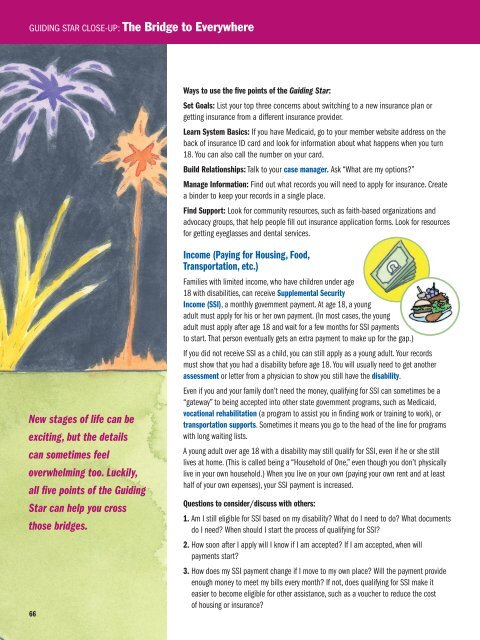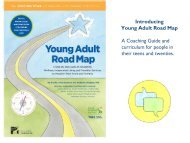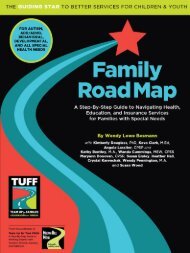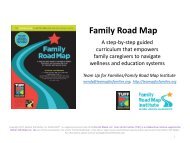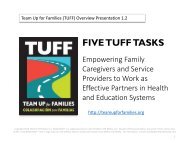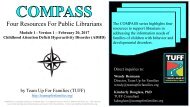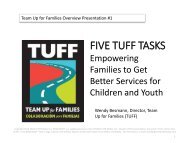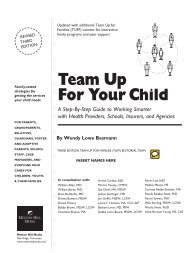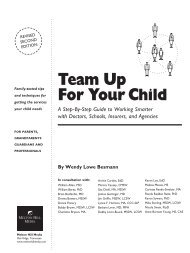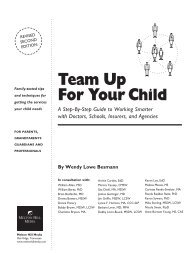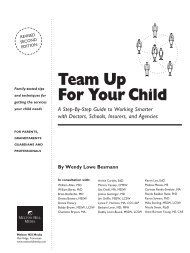Look Inside Young Adult Road Map
Create successful ePaper yourself
Turn your PDF publications into a flip-book with our unique Google optimized e-Paper software.
Guiding Star Close-up: The Bridge to Everywhere<br />
Ways to use the five points of the Guiding Star:<br />
Set Goals: List your top three concerns about switching to a new insurance plan or<br />
getting insurance from a different insurance provider.<br />
Learn System Basics: If you have Medicaid, go to your member website address on the<br />
back of insurance ID card and look for information about what happens when you turn<br />
18. You can also call the number on your card.<br />
Build Relationships: Talk to your case manager. Ask “What are my options?”<br />
Manage Information: Find out what records you will need to apply for insurance. Create<br />
a binder to keep your records in a single place.<br />
Find Support: <strong>Look</strong> for community resources, such as faith-based organizations and<br />
advocacy groups, that help people fill out insurance application forms. <strong>Look</strong> for resources<br />
for getting eyeglasses and dental services.<br />
New stages of life can be<br />
exciting, but the details<br />
can sometimes feel<br />
overwhelming too. Luckily,<br />
all five points of the Guiding<br />
Star can help you cross<br />
those bridges.<br />
66<br />
Income (Paying for Housing, Food,<br />
Transportation, etc.)<br />
Families with limited income, who have children under age<br />
18 with disabilities, can receive Supplemental Security<br />
Income (SSI), a monthly government payment. At age 18, a young<br />
adult must apply for his or her own payment. (In most cases, the young<br />
adult must apply after age 18 and wait for a few months for SSI payments<br />
to start. That person eventually gets an extra payment to make up for the gap.)<br />
If you did not receive SSI as a child, you can still apply as a young adult. Your records<br />
must show that you had a disability before age 18. You will usually need to get another<br />
assessment or letter from a physician to show you still have the disability.<br />
Even if you and your family don’t need the money, qualifying for SSI can sometimes be a<br />
“gateway” to being accepted into other state government programs, such as Medicaid,<br />
vocational rehabilitation (a program to assist you in finding work or training to work), or<br />
transportation supports. Sometimes it means you go to the head of the line for programs<br />
with long waiting lists.<br />
A young adult over age 18 with a disability may still qualify for SSI, even if he or she still<br />
lives at home. (This is called being a “Household of One,” even though you don’t physically<br />
live in your own household.) When you live on your own (paying your own rent and at least<br />
half of your own expenses), your SSI payment is increased.<br />
Questions to consider/discuss with others:<br />
1. Am I still eligible for SSI based on my disability? What do I need to do? What documents<br />
do I need? When should I start the process of qualifying for SSI?<br />
2. How soon after I apply will I know if I am accepted? If I am accepted, when will<br />
payments start?<br />
3. How does my SSI payment change if I move to my own place? Will the payment provide<br />
enough money to meet my bills every month? If not, does qualifying for SSI make it<br />
easier to become eligible for other assistance, such as a voucher to reduce the cost<br />
of housing or insurance?


